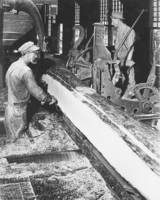
To supply their modest needs for lumber, early settlers used man-powered whip saws and water-powered sawmills. As the need grew, steam-powered circular sawmills were developed in the early 1800s. In 1835, there were 15 such mills in Western Virginia. With the coming of the first railroads shortly before the Civil War, the number of steam mills rapidly expanded, and by 1880 there were more than 400 of them in West Virginia. These mills were mostly small and portable, and had little effect on the vast timber reserves of the state. As late as 1870, two-thirds of West Virginia was still covered by old-growth forest.
It was not until the introduction of the band sawmill that lumber production dramatically increased. Rather than a toothed circular blade, the band saw was a long, thin, continuous band of steel, eight to 13 inches wide and with teeth on one edge. The band saw ran over wheels as large as eight feet in diameter. These wheels carried the saw at great speeds. The band saw cut lumber faster than circular saws, and it made a thinner cut, wasting less wood as sawdust.
Logs were brought to the mill on railroads built for the purpose. At the mill they were dumped into a pond. The logs were then carried up a ramp on a cleated chain into the mill, rolled onto the carriage, and carried past the saw where boards were cut. After trimming, the lumber was graded and moved to dry kilns for kiln drying or stacked in ventilated piles for air drying. Machinery in the mill, other than the carriage, was operated by belts running off a long main drive shaft which, in turn, was run by a belt from the steam engine. The carriage was powered by a steam cylinder. Unusable slabs, sawdust, and scrap wood were burned to provide heat for steam generation.
The first band mill to operate in West Virginia was in 1875. As railroads made the state more accessible, the number of band mills greatly increased. By 1909, the peak year of lumber production in West Virginia, there were 83 band mills and 1,441 other lumber mills. Almost 1.5 billion board feet of lumber was produced that year. Prior to 1920, more than 180 band mills had operated or were operating in the state. Approximately 30 billion board feet of lumber was cut in West Virginia from 1880 to 1920, estimated to be enough to build a boardwalk two inches thick and 13 feet wide from the earth to the moon.
The original forests were depleted during this period, and after that the lumber industry rapidly declined. By 1920, there were only 398 sawmills operating in the state, surviving by making a second cutting of trees. The day of the big bandsaw mills was over in West Virginia. Giant steam-powered mills gave way to smaller mills powered by diesel engines and electricity.
Nature has amazing powers of recuperation, however, and in the early 21st century, West Virginia is the third most forested state in the United States with more than 12 million acres of forest. In 2023, these timber lands supported 164 mills, which manufactured 75 billion board feet of lumber and other wood products—making West Virginia the second leading hardwood producer in the nation. The lumber industry is again thriving, employing 30,000 workers and contributing $3.2 billion annually to the economy of West Virginia.
This Article was written by Roy B. Clarkson
Last Revised on August 17, 2023
Related Articles
Sources
Clarkson, Roy B. Tumult on the Mountains: Lumbering in West Virginia 1770-1920. Parsons: McClain, 1964.
Brooks, A. B. Forestry and Wood Industries. Morgantown: West Virginia Geological & Economic Survey, 1910.
Cite This Article
Clarkson, Roy B. "Sawmills." e-WV: The West Virginia Encyclopedia. 17 August 2023. Web. 26 July 2024.


Comments?
There aren't any comments for this article yet.
Click here to read and contribute to the discussion →